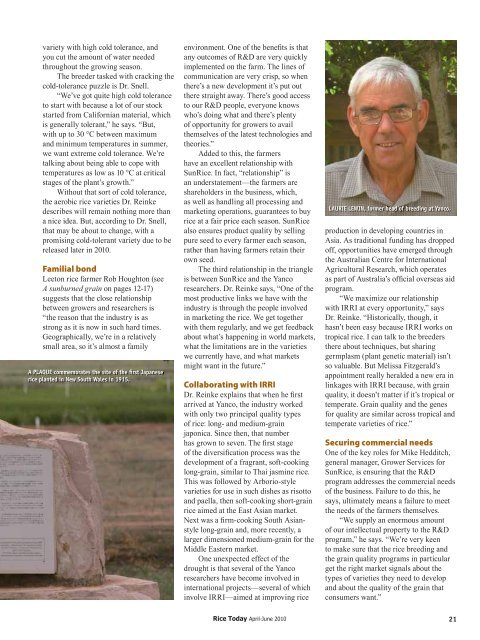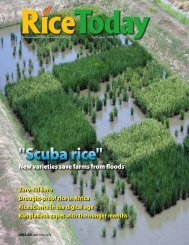A sunburned grain Stamps of approval Pockets of gold in ... - adron.sr
A sunburned grain Stamps of approval Pockets of gold in ... - adron.sr
A sunburned grain Stamps of approval Pockets of gold in ... - adron.sr
You also want an ePaper? Increase the reach of your titles
YUMPU automatically turns print PDFs into web optimized ePapers that Google loves.
variety with high cold tolerance, andyou cut the amount <strong>of</strong> water neededthroughout the grow<strong>in</strong>g season.The breeder tasked with crack<strong>in</strong>g thecold-tolerance puzzle is Dr. Snell.“We’ve got quite high cold toleranceto start with because a lot <strong>of</strong> our stockstarted from Californian material, whichis generally tolerant,” he says. “But,with up to 30 °C between maximumand m<strong>in</strong>imum temperatures <strong>in</strong> summer,we want extreme cold tolerance. We’retalk<strong>in</strong>g about be<strong>in</strong>g able to cope withtemperatures as low as 10 °C at criticalstages <strong>of</strong> the plant’s growth.”Without that sort <strong>of</strong> cold tolerance,the aerobic rice varieties Dr. Re<strong>in</strong>kedescribes will rema<strong>in</strong> noth<strong>in</strong>g more thana nice idea. But, accord<strong>in</strong>g to Dr. Snell,that may be about to change, with apromis<strong>in</strong>g cold-tolerant variety due to bereleased later <strong>in</strong> 2010.Familial bondLeeton rice farmer Rob Houghton (seeA <strong>sunburned</strong> <strong>gra<strong>in</strong></strong> on pages 12-17)suggests that the close relationshipbetween growers and researchers is“the reason that the <strong>in</strong>dustry is asstrong as it is now <strong>in</strong> such hard times.Geographically, we’re <strong>in</strong> a relativelysmall area, so it’s almost a familyA PLAQUE commemorates the site <strong>of</strong> the first Japaneserice planted <strong>in</strong> New South Wales <strong>in</strong> 1915.environment. One <strong>of</strong> the benefits is thatany outcomes <strong>of</strong> R&D are very quicklyimplemented on the farm. The l<strong>in</strong>es <strong>of</strong>communication are very crisp, so whenthere’s a new development it’s put outthere straight away. There’s good accessto our R&D people, everyone knowswho’s do<strong>in</strong>g what and there’s plenty<strong>of</strong> opportunity for growers to availthemselves <strong>of</strong> the latest technologies andtheories.”Added to this, the farmershave an excellent relationship withSunRice. In fact, “relationship” isan understatement—the farmers areshareholders <strong>in</strong> the bus<strong>in</strong>ess, which,as well as handl<strong>in</strong>g all process<strong>in</strong>g andmarket<strong>in</strong>g operations, guarantees to buyrice at a fair price each season. SunRicealso ensures product quality by sell<strong>in</strong>gpure seed to every farmer each season,rather than hav<strong>in</strong>g farmers reta<strong>in</strong> theirown seed.The third relationship <strong>in</strong> the triangleis between SunRice and the Yancoresearchers. Dr. Re<strong>in</strong>ke says, “One <strong>of</strong> themost productive l<strong>in</strong>ks we have with the<strong>in</strong>dustry is through the people <strong>in</strong>volved<strong>in</strong> market<strong>in</strong>g the rice. We get togetherwith them regularly, and we get feedbackabout what’s happen<strong>in</strong>g <strong>in</strong> world markets,what the limitations are <strong>in</strong> the varietieswe currently have, and what marketsmight want <strong>in</strong> the future.”Collaborat<strong>in</strong>g with IRRIDr. Re<strong>in</strong>ke expla<strong>in</strong>s that when he firstarrived at Yanco, the <strong>in</strong>dustry workedwith only two pr<strong>in</strong>cipal quality types<strong>of</strong> rice: long- and medium-<strong>gra<strong>in</strong></strong>japonica. S<strong>in</strong>ce then, that numberhas grown to seven. The first stage<strong>of</strong> the diversification process was thedevelopment <strong>of</strong> a fragrant, s<strong>of</strong>t-cook<strong>in</strong>glong-<strong>gra<strong>in</strong></strong>, similar to Thai jasm<strong>in</strong>e rice.This was followed by Arborio-stylevarieties for use <strong>in</strong> such dishes as risottoand paella, then s<strong>of</strong>t-cook<strong>in</strong>g short-<strong>gra<strong>in</strong></strong>rice aimed at the East Asian market.Next was a firm-cook<strong>in</strong>g South Asianstylelong-<strong>gra<strong>in</strong></strong> and, more recently, alarger dimensioned medium-<strong>gra<strong>in</strong></strong> for theMiddle Eastern market.One unexpected effect <strong>of</strong> thedrought is that several <strong>of</strong> the Yancoresearchers have become <strong>in</strong>volved <strong>in</strong><strong>in</strong>ternational projects—several <strong>of</strong> which<strong>in</strong>volve IRRI—aimed at improv<strong>in</strong>g riceLAURIE LEWIN, former head <strong>of</strong> breed<strong>in</strong>g at Yanco.production <strong>in</strong> develop<strong>in</strong>g countries <strong>in</strong>Asia. As traditional fund<strong>in</strong>g has dropped<strong>of</strong>f, opportunities have emerged throughthe Australian Centre for InternationalAgricultural Research, which operatesas part <strong>of</strong> Australia’s <strong>of</strong>ficial overseas aidprogram.“We maximize our relationshipwith IRRI at every opportunity,” saysDr. Re<strong>in</strong>ke. “Historically, though, ithasn’t been easy because IRRI works ontropical rice. I can talk to the breedersthere about techniques, but shar<strong>in</strong>ggermplasm (plant genetic material) isn’tso valuable. But Melissa Fitzgerald’sappo<strong>in</strong>tment really heralded a new era <strong>in</strong>l<strong>in</strong>kages with IRRI because, with <strong>gra<strong>in</strong></strong>quality, it doesn’t matter if it’s tropical ortemperate. Gra<strong>in</strong> quality and the genesfor quality are similar across tropical andtemperate varieties <strong>of</strong> rice.”Secur<strong>in</strong>g commercial needsOne <strong>of</strong> the key roles for Mike Hedditch,general manager, Grower Services forSunRice, is ensur<strong>in</strong>g that the R&Dprogram addresses the commercial needs<strong>of</strong> the bus<strong>in</strong>ess. Failure to do this, hesays, ultimately means a failure to meetthe needs <strong>of</strong> the farmers themselves.“We supply an enormous amount<strong>of</strong> our <strong>in</strong>tellectual property to the R&Dprogram,” he says. “We’re very keento make sure that the rice breed<strong>in</strong>g andthe <strong>gra<strong>in</strong></strong> quality programs <strong>in</strong> particularget the right market signals about thetypes <strong>of</strong> varieties they need to developand about the quality <strong>of</strong> the <strong>gra<strong>in</strong></strong> thatconsumers want.”Rice Today April-June 201021

















